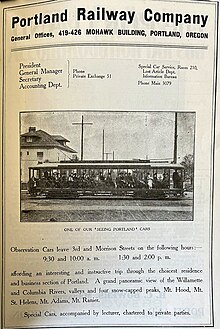 | |
| Company type | Public |
|---|---|
| Industry | Public utility |
| Founded | 1906 |
| Fate | Acquired by Portland Electric Power Company (1924) |
| Headquarters | Portland, Oregon, U.S. |
Key people | Franklin Griffith [1] |
| Products | Electric power, transportation |
The Portland Railway, Light and Power Company (PRL&P) was a railway company and electric power utility in Portland, Oregon, United States, from 1906 until 1924. [2]
History



A series of mergers of various transportation companies in 1905–1906 [3] culminating in the merger of the Portland Street Railway Company; Oregon Water, Power and Railway Company; and the Portland General Electric Company on June 28, 1906, established the Portland Railway, Light and Power Company (PRL&P). [2] Nearly 200 miles of track and 375 urban and interurban streetcars were thereupon consolidated under a single company. [2] Upon its formation, PRL&P became the only company to operate streetcars within Portland city limits; it also continued to sell electric power. [4] The name, Portland General Electric (PGE), remained in use as a division of PRL&P and, after subsequent reorganizations in 1930 and 1940 [3] eventually PGE became once again fully independent as a power utility company, making PGE in some ways both an ancestor and a descendant of PRL&P.
The company's interurban lines used standard-gauge track, with the exception of the line to Vancouver, Washington, while most of its urban (or "city") lines were narrow-gauge, specifically 3 ft 6 in (1067 mm) gauge. [3] A few lines in the southeast part of the city were standard-gauge, [5] converted from narrow gauge in December 1908 for efficiency, so that they could operate out of PRL&P's Sellwood carbarn, which was closer to the area those lines served but was only equipped for standard-gauge operation. [3]: 129–130
By 1910, PRL&P was a $15 million holding company, having received 43 franchises from the city of Portland, mostly in the form of land grants. [6] It was a monopoly, and "liable to anti-trust action under the Sherman Act." [6] [7] The company only installed safety devices (such as pedestrian bumpers) on its streetcars after "extreme public pressure." [6] While PRL&P installed many public streetlights, the city council complained about the power rates charged to the city. [6]
PRL&P's president, Franklin Griffith, was part of the corruption and graft surrounding Mayor George Luis Baker; Griffith and others paid off Baker's mortgage. [1]

PRL&P was reorganized as the Portland Electric Power Company (PEPCO) on April 26, 1924. [2]
Two former PRL&P streetcar buildings are listed on the National Register of Historic Places. Bay E of the West Ankeny Carbarns was listed in 1978, [8] and the Sellwood Division Carbarn Office and Clubhouse was listed in 2002. [9] The company's 1911 hydroelectric facility in Estacada, Oregon, the River Mill Hydroelectric Project, is also listed on the NRHP. [10]
See also
References
- ^ a b Chandler, J. D. (2016). Murder & scandal in prohibition Portland : sex, vice & misdeeds in Mayor Baker's reign. Charleston, SC: The History Press. p. 115. ISBN 1-4671-1953-9. OCLC 928581539.
- ^ a b c d Thompson, Richard M. (2006). Portland's Streetcars, pp. 57 and 99. Arcadia Publishing. ISBN 0-7385-3115-4.
- ^ a b c d Labbe, John T. (1980). Fares Please! Those Portland Trolley Years, pp. 118–123. Caldwell, ID (US): Caxton. ISBN 0-87004-287-4.
- ^ Tucker, Kathy (2003). "Portland Railway Company Car (photo)". Oregon Historical Society.
- ^ Thompson, Richard M. (2010). Portland's Streetcar Lines. Arcadia Publishing. p. 98. ISBN 978-0-7385-8126-2.
- ^ a b c d MacColl, E. Kimbark (November 1976). The Shaping of a City: Business and Politics in Portland, Oregon 1885 to 1915. Portland, Oregon: The Georgian Press Company. p. 10. OCLC 2645815.
- ^ Cited in MacColl as "American Banker", May 28, 1910
- ^ Alfred M. Staehli (March 2, 1978). "National Register of Historic Places Inventory – Nomination Form: Bay E, West Ankeny Car Barns" (PDF). National Park Service. Retrieved December 26, 2014.
- ^ Dodds, Linda; Dodds, Gordon (June 1, 2001). "National Register of Historic Places Registration Form: Portland Railway, Light and Power Sellwood Division Carbarn Office and Clubhouse" (PDF). National Park Service. Retrieved April 22, 2012.
- ^ https://npgallery.nps.gov/NRHP/GetAsset/NRHP/01000497_text
Further reading
- Mills, Randall V. (March 1943). "Early Electric Interurbans in Oregon". Oregon Historical Quarterly. 44 (1): 82–104. JSTOR 20611476.
External links
- Kramer, George. "Portland Railway, Light and Power Company". The Oregon Encyclopedia.
- Oregon railroads
- Electric power companies of the United States
- Streetcars in Oregon
- Electric railways in Oregon
- Transportation in Portland, Oregon
- History of Portland, Oregon
- Portland General Electric
- 1906 establishments in Oregon
- History of transportation in Oregon
- 3 ft 6 in gauge railways in the United States
- Standard gauge railways in the United States
- Tram, urban railway and trolley companies